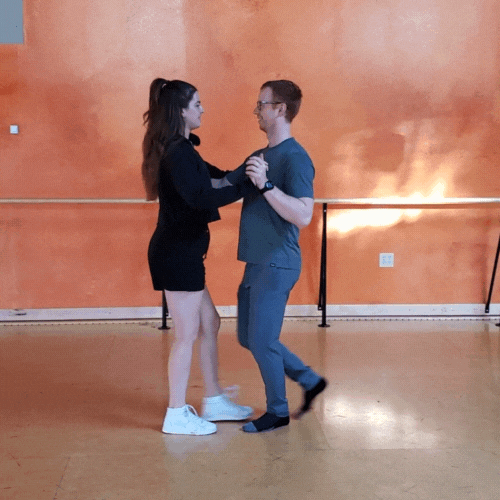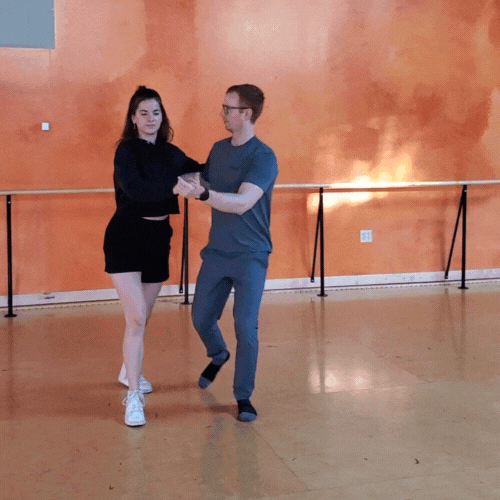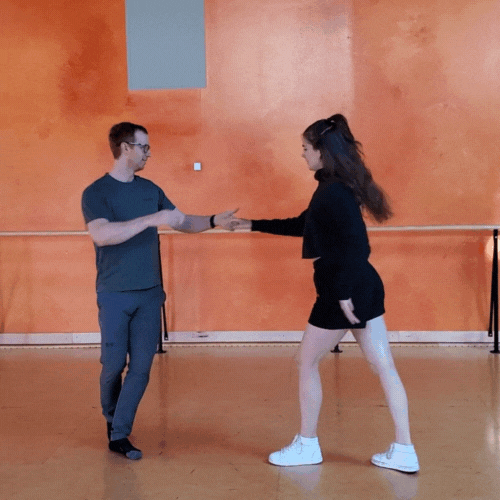7 Foundational Zouk Moves All Beginners Should Know
One challenge several of our new students have mentioned is simply being able to keep track of the names of all of the moves! So today we’re giving you a “cheat sheet” with visuals of some of the most common zouk moves we think are foundational for beginner students to master.
1. Passo Básico (Basic Step)
This is our regular ol’ forward-and-backward (“frente e trás” in Portuguese) basic step, done to the “slow, quick quick” or “boom, chic chic” zouk beat.
Why this is a “foundational” move: The basic step does it all! It teaches us to work on our dance frame and connection with our partner, the importance of projecting our feet when we step, and how to step on the zouk beat even while traveling.
2. Lateral
The lateral can be considered another of our basic steps because it is SO common. As the name suggests, the dancers are moving laterally (sideways). Notice that unlike the forward-and-back-ward basic, the leader and the follower are doing completely different footwork!
Why this is a “foundational” move: The lateral step helps followers practice the ooey-gooey delay of waiting to feel the pull from the lead to step across. It’s also often a dancer’s first experience with doing a move where the leader’s and follower’s footwork is different, so you can no longer sneak a peek at your partner’s feet to remind yourself what to do…
3. Viradinha
“Viradinha” comes from the word “virada,” or “turn” in Portuguese. When we add the diminutive “inha” (meaning “little”) to the end of the word, virada becomes viradinha, aka “little turn.” I like to think of this one as just a cute wee little turn - nothing to be intimidated by!
Why this is a “foundational” move: This is a great move for both leaders and followers to work on their frame - specifically how their arms connect to their torso (which then connects to their hips and their feet). If either partner’s frame is noodle-y, this move won’t feel clear. Keeping the tension and the connection through the arms to the chest is the secret to the leader being able to pivot the follower forward and backwards in this viradinha.
4. Lunge + Simple Turn
This lunge into a simple turn can be used as a way to transition from the lateral step back into the basic step, and it’s one of the first “combos” we teach in our Zouk Foundations class.
Why this is a “foundational” move: In addition to being a good example of practicing stringing various moves and steps together, the lunge is a great move for leaders to have in their toolkit because it allows them to play with musicality. The leader can choose to sloooooow the lunge down (and followers will have to practice following and waiting for the lead to exit the lunge), or to keep it quick and peppy. Personally, I also use the lunge all the time when I lead if I get off beat, then I can wait for the correct timing to turn back into our basic step and come back to dancing on time!
5. Soltinho
“Soltinho” comes from the Portuguese word “solta,” meaning free/loose/released. And just like how viradinha means little turn, soltinho means a little loose (or “flowy”). For folks who’ve danced salsa, this can feel a little bit like a para mi para ti.
Why this is a “foundational” move: The soltinho footwork is something that’s used in pieces in other more complicated moves. It can also be done without a partner, which serves as the basis for how we can walk in a party dance where multiple dancers are walking around a couple, preparing to swap in and “steal” one of the dancers.
6. Ioiô (Yo-Yo)
Yo-yo (or “Ioiô “ in Portuguese) is an easy one to remember because the leader is winding the follower in and out like a yo-yo on a string.
Why this is a “foundational” move: For leaders, this move is a great example of learning to “follow the follow” to be able to trace their arm comfortably around their body. For followers, this is move helps us work both on a traveling turn, as well as controlling that turn (to stop with control, and reverse the direction).
7. Bônus / Boomerang
While these two names are often used interchangeably to describe the same move (where the follower is led spinning across the lead), technically they refer to two variations. The “bonus,” which uses a hand connection throughout (shown above) was a “bonus move” taught to students who were excelling in zouk classes as a fun/cool challenge. A “boomerang” refers to when the leader releases their hand and the follower continues the bonus footwork, returning back to the lead (like a boomerang) even without the hand connection to lead.
Why this is a “foundational” move: For followers, the bônus requires a traveling turn that rotates through a full 360 and another 180 (for a full 1.5 turns, or more if the leader chooses to start the move from a lunge), which is great practice for future moves that use traveling turns. For leaders, the bônus helps teach understanding the followers’ “tracks” and leading with an impulse. It can also be a good move to practice differentiating between leading the ending in a lateral/cross step, or opening into a lunge.
What’s On Your Go-To Beginner Move List?
These moves are just the tip of the iceberg when it comes to learning zouk. In our Zouk Foundations classes Tuesday nights we work on moves like these and so many more (cuddles, ochos, body rolls, turn variations…) so that even beginners can expand their dance vocabulary and have fun social dancing.
What moves are part of your go-to arsenal when dancing with beginners? Let us know in the comments!







